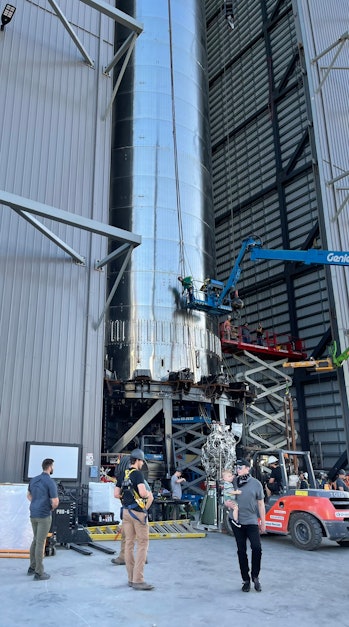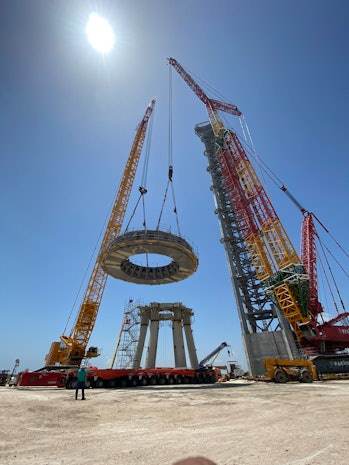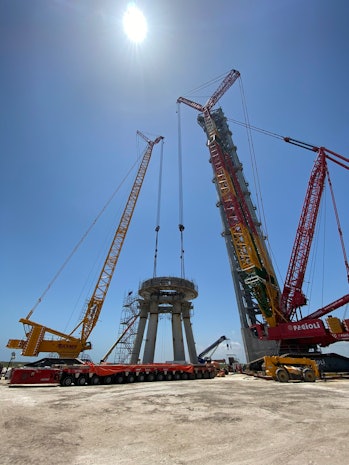As Starship gears up for its next big challenge, new images show the true size of the still under-development SpaceX rocket designed to one day transport humans to Mars.
This weekend, SpaceX CEO Elon Musk shared photos on Twitter of a fresh prototype of the Starship at the firm’s Texas facility, Starbase, which houses SpaceX’s most ambitious rocket yet.
Here’s the background — SpaceX aims to launch a prototype Starship on an orbital trip in the second half of 2021. The plan, first revealed in an FCC document in May, involves launching the ship into orbit with the help of SpaceX’s Super Heavy booster.
The flight, expected to last around 90 minutes, will culminate in the ship completing a targeted landing on one of the SpaceX drone ships stationed in the ocean some 60 miles northwest of Hawaii.
The orbital test is the next step in the plan to bring Starship to life. First unveiled in 2017 under the name “BFR,” Starship is designed to be a fully reusable ship able to send more than 100 tons or 100 people into space at one time. The ship will take on both the satellite and crew launching duties of the SpaceX rockets Falcon 9 and Falcon Heavy and enable more ambitious missions to take place — like a crewed mission to Mars.
SpaceX plans to send the first humans to Mars in the middle of this decade and establish the first city on Mars by 2050. No pressure.
Want to find out more about SpaceX and Starship? Subscribe to MUSK READS+ for exclusive interviews and analysis about spaceflight, electric cars, and more.What the photos show — In the new batch of photos, Musk stands in front of the Super Heavy booster that will support the orbital flight prototype. While a Starship prototype has completed a high-altitude flight, the Super Heavy booster has never flown before.  Musk and X standing in front of the booster.TwitterWhen paired together, the Super Heavy booster and Starship prototype will measure around 400 feet tall. The booster alone is 230 feet tall — comparable in height to SpaceX’s current Falcon 9 rocket. In one photo, seen above, Musk cradles his son X Æ A-Xii. Musk’s partner, Canadian signer Claire Boucher (also known as Grimes), gave birth to their son on May 4, 2020.In the foreground of the same image, a forklift rolls a Raptor engine into position. The booster will use 33 engines — equating to half a million pounds of thrust at launch.SpaceX is working to build Raptor engines at rapid speed. Last week, the firm announced it had built its 100th Raptor engine.
Musk and X standing in front of the booster.TwitterWhen paired together, the Super Heavy booster and Starship prototype will measure around 400 feet tall. The booster alone is 230 feet tall — comparable in height to SpaceX’s current Falcon 9 rocket. In one photo, seen above, Musk cradles his son X Æ A-Xii. Musk’s partner, Canadian signer Claire Boucher (also known as Grimes), gave birth to their son on May 4, 2020.In the foreground of the same image, a forklift rolls a Raptor engine into position. The booster will use 33 engines — equating to half a million pounds of thrust at launch.SpaceX is working to build Raptor engines at rapid speed. Last week, the firm announced it had built its 100th Raptor engine. SpaceX's 100th Raptor engine completed.TwitterMusk shared another series of photos with the caption “Starbase is moving at Warp 9.” The comment is a reference to Star Trek, where warp factors are used to refer to spaceships’ high speeds.
SpaceX's 100th Raptor engine completed.TwitterMusk shared another series of photos with the caption “Starbase is moving at Warp 9.” The comment is a reference to Star Trek, where warp factors are used to refer to spaceships’ high speeds. The launch table coming together.TwitterThe images show the launch table, which will support Starship, coming together. The table is designed to pair with the launch tower seen on the right.
The launch table coming together.TwitterThe images show the launch table, which will support Starship, coming together. The table is designed to pair with the launch tower seen on the right. Lowering the launch table section into position.TwitterMusk shared a clearer shot of the launch tower in a previous set of images shared on July 1:
Lowering the launch table section into position.TwitterMusk shared a clearer shot of the launch tower in a previous set of images shared on July 1: Musk's photos of the booster and launch tower.TwitterMusk revealed on Twitter that the launch table section pictured weighs about 370 tons.
Musk's photos of the booster and launch tower.TwitterMusk revealed on Twitter that the launch table section pictured weighs about 370 tons. The launch table will support the upcoming Starship orbital mission.TwitterThe next step, Musk explained, will be to check if the table is level and matches the booster fittings. The team should find out Tuesday if they were successful.SPACEX STARSHIP ORBITAL FLIGHT: HOW DID WE GET HERE?November 2018 — BFR, first announced in September 2017, gets renamed to Starship.December 2018 — Musk confirms the new ship has switched to stainless steel.January 2019 — Shortened “Starhopper” prototype unveiled, and Musk explains the switch to steel.February 2019 — Raptor engine beats a long-standing rocket record.April 2019 — Starhopper completes a tethered “hop.”July 2019 — Starhopper launches 20 meters (67 feet).August 2019 — Starhopper launches 150 meters (500 feet).September 2019 — Starship Mk.1 full-size prototype unveiled.May 2020 — Starship SN4 full-size prototype completes a static test fire.August 2020 — SN5 launches 150 meters (500 feet).October 2020 — SN8 completes the first triple-Raptor static fire.December 2020 — SN8 launches 12.5 kilometers (41,000 feet) and crashes into the ground.February 2021 — SN9 launches 10 kilometers (33,000 feet) and crashes into the ground.March 2021 — SN10 launches 10 kilometers (33,000 feet), lands, and explodes eight minutes later. That same month, SN11 launches 10 kilometers (33,000 feet) and hits the ground in several pieces.May 2021 — SN15 launches 10 kilometers (33,000 feet) and lands without a hitch, except for a small fire at the base.SUBSCRIBE TO MUSK READS+, A PREMIUM NEWSLETTER THAT COVERS THE WORLDS OF ELON MUSK, SPACEX, TESLA, AND EVERYTHING BETWEEN.
The launch table will support the upcoming Starship orbital mission.TwitterThe next step, Musk explained, will be to check if the table is level and matches the booster fittings. The team should find out Tuesday if they were successful.SPACEX STARSHIP ORBITAL FLIGHT: HOW DID WE GET HERE?November 2018 — BFR, first announced in September 2017, gets renamed to Starship.December 2018 — Musk confirms the new ship has switched to stainless steel.January 2019 — Shortened “Starhopper” prototype unveiled, and Musk explains the switch to steel.February 2019 — Raptor engine beats a long-standing rocket record.April 2019 — Starhopper completes a tethered “hop.”July 2019 — Starhopper launches 20 meters (67 feet).August 2019 — Starhopper launches 150 meters (500 feet).September 2019 — Starship Mk.1 full-size prototype unveiled.May 2020 — Starship SN4 full-size prototype completes a static test fire.August 2020 — SN5 launches 150 meters (500 feet).October 2020 — SN8 completes the first triple-Raptor static fire.December 2020 — SN8 launches 12.5 kilometers (41,000 feet) and crashes into the ground.February 2021 — SN9 launches 10 kilometers (33,000 feet) and crashes into the ground.March 2021 — SN10 launches 10 kilometers (33,000 feet), lands, and explodes eight minutes later. That same month, SN11 launches 10 kilometers (33,000 feet) and hits the ground in several pieces.May 2021 — SN15 launches 10 kilometers (33,000 feet) and lands without a hitch, except for a small fire at the base.SUBSCRIBE TO MUSK READS+, A PREMIUM NEWSLETTER THAT COVERS THE WORLDS OF ELON MUSK, SPACEX, TESLA, AND EVERYTHING BETWEEN.


 Musk and X standing in front of the booster.TwitterWhen paired together, the Super Heavy booster and Starship prototype will measure around 400 feet tall. The booster alone is 230 feet tall — comparable in height to SpaceX’s current Falcon 9 rocket. In one photo, seen above, Musk
Musk and X standing in front of the booster.TwitterWhen paired together, the Super Heavy booster and Starship prototype will measure around 400 feet tall. The booster alone is 230 feet tall — comparable in height to SpaceX’s current Falcon 9 rocket. In one photo, seen above, Musk  SpaceX's 100th Raptor engine completed.TwitterMusk shared another series of photos with the caption “Starbase is moving at Warp 9.” The comment is a reference to Star Trek, where warp factors are used to refer to spaceships’ high speeds.
SpaceX's 100th Raptor engine completed.TwitterMusk shared another series of photos with the caption “Starbase is moving at Warp 9.” The comment is a reference to Star Trek, where warp factors are used to refer to spaceships’ high speeds. The launch table coming together.TwitterThe images show the launch table, which will support Starship, coming together. The table is designed to pair with the launch tower seen on the right.
The launch table coming together.TwitterThe images show the launch table, which will support Starship, coming together. The table is designed to pair with the launch tower seen on the right. Lowering the launch table section into position.TwitterMusk shared a clearer shot of the launch tower in a previous set of images
Lowering the launch table section into position.TwitterMusk shared a clearer shot of the launch tower in a previous set of images  Musk's photos of the booster and launch tower.TwitterMusk revealed on Twitter that the launch table section pictured weighs about 370 tons.
Musk's photos of the booster and launch tower.TwitterMusk revealed on Twitter that the launch table section pictured weighs about 370 tons. The launch table will support the upcoming Starship orbital mission.TwitterThe next step,
The launch table will support the upcoming Starship orbital mission.TwitterThe next step, 











